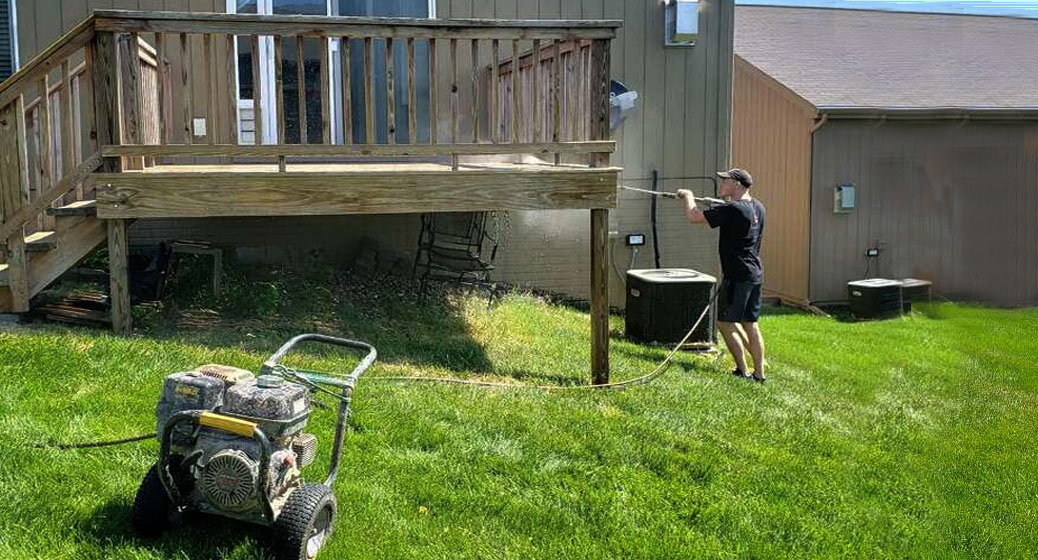Deck Staining 101: Everything You Required to Know for a DIY Job
From preparing the deck surface to picking the ideal type of stain and grasping the application strategies, each action plays a vital role in accomplishing an expert finish. Join us as we decipher the important guidelines and insider tips for mastering the art of deck staining, making certain a successful DIY project that will certainly leave your deck looking flawless.
Value of Deck Staining
Deck discoloration is an important maintenance job that maintains the durability and appearance of outdoor wooden frameworks. Wooden decks are continuously subjected to rough elements such as sunlight, snow, foot, and rainfall traffic, all of which can bring about tear and wear with time. By using a coat of tarnish to the deck's surface, you produce a protective obstacle that helps avoid wetness penetration, UV damage, and decomposing of the timber. This not just extends the life-span of the deck but also maintains its aesthetic appeal.
It offers a possibility to tailor the look of the deck by picking from a selection of tarnish surfaces and shades. In significance, normal deck discoloration is a basic yet efficient method to guarantee your deck stays structurally sound and visually pleasing for years to come.
Deck Preparation Tips

After cleaning and fixing, fining sand the deck is required to smooth out harsh surface areas and open up the wood's pores to far better absorb the tarnish. As soon as the deck is tidy, dry, and smooth, safeguard any type of nearby plants, furniture, or surface areas with a drop towel before using the deck tarnish.
Selecting the Right Stain
Selecting the suitable tarnish for your deck is an important choice that straight affects both its look and resilience. When selecting the appropriate stain, there are a number of variables to think about to ensure a successful DIY project.
First of all, you need to choose between transparent, semi-transparent, and solid discolorations. Transparent discolorations permit the natural grain of the timber to show with however use marginal defense against UV rays and wetness. Semi-transparent discolorations give a concession between color and protection, while solid discolorations offer one of the most protection however cover the timber grain.
Following, think about the kind of timber your deck is made from, as various stains work much better with certain wood species. Cedar and redwood decks often look ideal with a clear or semi-transparent stain to highlight their all-natural beauty. Pressure-treated wood may benefit from a strong discolor to conceal flaws.
Finally, consider the environment in your location. Choose for a tarnish with UV defense and resistance to extreme climate conditions if you experience rough winters or intense sunlight. By very carefully thinking about these elements, you can select a stain that improves your deck's looks and longevity.

Applying Stain Properly
When thinking about the application of stain to your deck, it is necessary to pay very close attention to the particular qualities of the stain selected and just how it interacts with the sort check over here of timber and ecological conditions formerly mulled over. Before starting the discoloration procedure, ensure that the deck surface is tidy, dry, and without any previous coverings or debris. It is suggested to evaluate the selected tarnish on a tiny unnoticeable location of the deck to make sure compatibility and achieve the preferred color and finish.
Use the tarnish along the size of the deck boards to stop irregular merging - deck cleaning nashville. It is essential to function with the wood grain to enhance the natural beauty of the deck and enable for much better infiltration of the discolor.
Maintenance and Care Tips

An additional important facet of deck maintenance is protecting it from the components. Think about applying a waterproof sealant every few years to shield the wood from dampness damages. Addressing any kind of mold or mildew quickly is crucial to avoid them from triggering architectural injury to your deck. Regularly cutting close-by foliage can likewise prevent fallen leaves and branches from building up on your deck and triggering possible damages.
Verdict
To conclude, deck staining is a vital step in preserving the look and long life of your outdoor area. By appropriately preparing the deck, selecting the right tarnish, applying it properly, and adhering to upkeep pointers, you can guarantee a sturdy and stunning finish that will certainly last for many years to come. Keep in mind to routinely check and care for your stained deck to maintain it looking its ideal.
Join us as we decipher the necessary standards and expert tips for mastering the art of deck staining, guaranteeing a successful DIY task that will certainly leave your deck looking impressive. - deck staining nashville
In significance, regular deck staining is a simple yet efficient view method to ensure your deck stays structurally audio and visually pleasing for years check here to come.
As soon as the deck is tidy, dry, and smooth, shield any kind of close-by plants, furniture, or surface areas with a decrease fabric prior to applying the deck tarnish.Following, take into consideration the type of timber your deck is made of, as various discolorations work much better with particular timber varieties.When considering the application of discolor to your deck, it is crucial to pay close attention to the details features of the discolor selected and just how it interacts with the kind of timber and ecological problems previously deliberated.